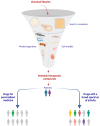Drug Drop Test: How to Quickly Identify Potential Therapeutic Compounds for Mitochondrial Diseases Using Yeast Saccharomyces cerevisiae
- PMID: 37445873
- PMCID: PMC10341415
- DOI: 10.3390/ijms241310696
Drug Drop Test: How to Quickly Identify Potential Therapeutic Compounds for Mitochondrial Diseases Using Yeast Saccharomyces cerevisiae
Abstract
Mitochondrial diseases (MDs) refer to a group of clinically and genetically heterogeneous pathologies characterized by defective mitochondrial function and energy production. Unfortunately, there is no effective treatment for most MDs, and current therapeutic management is limited to relieving symptoms. The yeast Saccharomyces cerevisiae has been efficiently used as a model organism to study mitochondria-related disorders thanks to its easy manipulation and well-known mitochondrial biogenesis and metabolism. It has been successfully exploited both to validate alleged pathogenic variants identified in patients and to discover potential beneficial molecules for their treatment. The so-called "drug drop test", a phenotype-based high-throughput screening, especially if coupled with a drug repurposing approach, allows the identification of molecules with high translational potential in a cost-effective and time-saving manner. In addition to drug identification, S. cerevisiae can be used to point out the drug's target or pathway. To date, drug drop tests have been successfully carried out for a variety of disease models, leading to very promising results. The most relevant aspect is that studies on more complex model organisms confirmed the effectiveness of the drugs, strengthening the results obtained in yeast and demonstrating the usefulness of this screening as a novel approach to revealing new therapeutic molecules for MDs.
Keywords: Saccharomyces cerevisiae; drug drop test; drug repurposing; mitochondrial diseases; yeast model.
Conflict of interest statement
The authors declare no conflict of interest.
Figures


Similar articles
-
A Yeast-Based Repurposing Approach for the Treatment of Mitochondrial DNA Depletion Syndromes Led to the Identification of Molecules Able to Modulate the dNTP Pool.Int J Mol Sci. 2021 Nov 12;22(22):12223. doi: 10.3390/ijms222212223. Int J Mol Sci. 2021. PMID: 34830106 Free PMC article.
-
Yeast models of human mitochondrial diseases: from molecular mechanisms to drug screening.Biotechnol J. 2006 Mar;1(3):270-81. doi: 10.1002/biot.200500053. Biotechnol J. 2006. PMID: 16897707 Review.
-
Yeast as a system for modeling mitochondrial disease mechanisms and discovering therapies.Dis Model Mech. 2015 Jun;8(6):509-26. doi: 10.1242/dmm.020438. Dis Model Mech. 2015. PMID: 26035862 Free PMC article. Review.
-
Mitochondrial protein sorting as a therapeutic target for ATP synthase disorders.Nat Commun. 2014 Dec 18;5:5585. doi: 10.1038/ncomms6585. Nat Commun. 2014. PMID: 25519239 Free PMC article.
-
A Yeast-Based Screening Unravels Potential Therapeutic Molecules for Mitochondrial Diseases Associated with Dominant ANT1 Mutations.Int J Mol Sci. 2021 Apr 24;22(9):4461. doi: 10.3390/ijms22094461. Int J Mol Sci. 2021. PMID: 33923309 Free PMC article.
Cited by
-
In Vivo Antioxidant Activity of Common Dietary Flavonoids: Insights from the Yeast Model Saccharomyces cerevisiae.Antioxidants (Basel). 2024 Sep 12;13(9):1103. doi: 10.3390/antiox13091103. Antioxidants (Basel). 2024. PMID: 39334762 Free PMC article.
-
Modelling phenotypes, variants and pathomechanisms of syndromic diseases in different systems.Med Genet. 2024 Jun 6;36(2):121-131. doi: 10.1515/medgen-2024-2020. eCollection 2024 Jun. Med Genet. 2024. PMID: 38854643 Free PMC article.
-
Harnessing Plant Flavonoids to Fight Pancreatic Cancer.Curr Nutr Rep. 2024 Sep;13(3):566-581. doi: 10.1007/s13668-024-00545-9. Epub 2024 May 3. Curr Nutr Rep. 2024. PMID: 38700837 Review.
References
-
- Guthrie C., Fink G.R. Guide to Yeast Genetics and Molecular Biology. Methods Enzymol. 1991;194:3–933. - PubMed
Publication types
MeSH terms
Substances
LinkOut - more resources
Full Text Sources
Medical
Molecular Biology Databases
Research Materials
Miscellaneous

